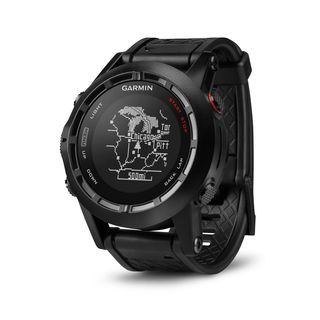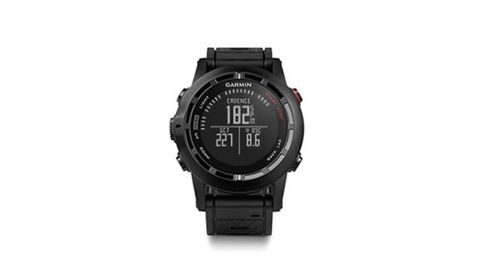You can trust Coach
Garmin’s latest GPS watch combines the very best of its fitness and outdoor ranges into one device, putting virtually every feature runners, hikers and mountaineers could want right on their wrist. The Fenix 2 includes a chest-worn heart rate monitor too, so you’ll have everything you need to start training as soon as you get it out of the box.
Getting started
The Fenix 2 may primarily be a watch for runners, but it can also track cycling, swimming, indoor workouts, hiking, mountaineering, skiing and parachute jumps – and that’s just the default modes. You can add custom workouts, custom routines and custom activities using the Garmin website (more on that below). The navigation mode will even put your assigned waypoints on a map, saving you the need to unfold an Ordnance Survey map when hiking.
Other built-in features include a digital barometer, compass, altimeter and thermometer, giving you everything you could possibly want to know either during or before setting off on a run.
The Fenix 2 is so dedicated to serious exercise that it lacks some of the more basic health and fitness features, like step tracking. You can add a £60 footpad to your shoes and count steps that way, but this is an annoying extra to have to add to a £400 watch.
At least you don’t have to add a heart rate monitor to the cost of the watch: the HRM-RUN strap included in the box uses ANT+ to send your heart rate to the Fenix 2. Unlike standard HRMs, however, it includes a second data channel specifically for Garmin products. This means you’ll be able to access more information when it comes to checking your progress after a run, as opposed to just buying the watch and using your existing HRM.
How does it work
The Fenix 2 has five buttons, for navigating through its comprehensive menu system and for activating the red backlight. To start an activity you simply press the big red button on the right, scroll up and down then hit the red button again. The watch will then search for any paired sensors, including the bundled HRM, search for satellite reception then send you on your way.
The whole process is quick, as long as you’re outdoors with clear line of sight to the sky, otherwise GPS synchronisation can take around a minute. Thankfully the watch caches your previous locations, meaning if you set off from the same spot every day it should find a satellite within five seconds.

GPS tracking isn’t exactly battery-friendly, but the Fenix 2 copes well. In one-second mode, which uses both GPS and ANT+ sensors every second to accurately track your workout, the watch should last for up to 16 hours of use – which should be sufficient for everything up to Ironman-distance events. There’s also an ultra-long battery mode, which should last for up to 55 hours, but here it only checks your location every 60 seconds – meaning less precise route information when you export your data. When not tracking and simply operating as a watch, you’ll easily get over a week of use on a single charge.
In order to keep the watch watertight, the Fenix 2 uses charging pins and a proprietary charger instead of a more common microUSB port. The cable will plug into any USB port, however, so you’ll be able to recharge the watch anywhere as long as you remember to pack the cable as well.
Syncing data
Just like the Garmin Vivofit fitness band, the Fenix 2 uses the Garmin Connect software and website to log your data online. Plugging the watch into a PC or Mac over USB will download the saved data and upload it to the website, where it can be analysed and compared with friends’ data using its social network features.
Garmin Connect has been seriously overhauled since it first launched, so now everything is easier to find and sensibly presented with a central dashboard giving an instant overview of your total activity, weekly friends leaderboard and recently awarded badges – incentives for hitting goals or reaching long-term targets that can be shared with friends on Facebook.
Whereas feedback was somewhat limited with the Vivofit band, Garmin Connect gives you detailed breakdowns of every part of your routine, including heart rate, elevation, split times and temperature. Each chart can be expanded for precise analysis, or exported to other websites.
Smartphone apps
With support for iOS, iPhone owners can download the Garmin Connect Mobile app and sync their data to their smartphone rather than connecting to a PC. It shows your completed workouts, lets you schedule future sessions and displays route maps based on collected GPS data, but Garmin Connect also doubles as a social network. You can add friends, check up on their recent activity and have people follow your progress.
The Fenix 2 even includes some smart watch functions too, displaying notifications from the iOS notification centre on your wrist when connected over Bluetooth. However, this mode drains the battery significantly, meaning you’ll only get around a day’s worth of use before needing to charge it up.

Unfortunately for Android owners, there’s currently no way to pair the watch to your handset – the app simply didn’t support it at the time of writing. We hope Garmin will fix this in the near future, because it’s annoying to have to sync with a PC every time. Garmin plans to add notification support to Android later this year.
Verdict
Although the Fenix 2 costs an eye-watering £390, it does just about everything you could hope for in a watch dedicated to exercise. It packs in more sensors and can track more activities or sports than virtually all of the competition, and the detailed feedback analysis available through the Garmin Connect website is a superb way to monitor your progress.
The watch’s iOS support is excellent, but until Android support is added a significant portion of users will be forced to sync through a PC rather than their phone. It’s also not the most stylish of watches, but in terms of ability it’s second to none.
Score: 8/10
RRP: £390
Manufacturer: Garmin

